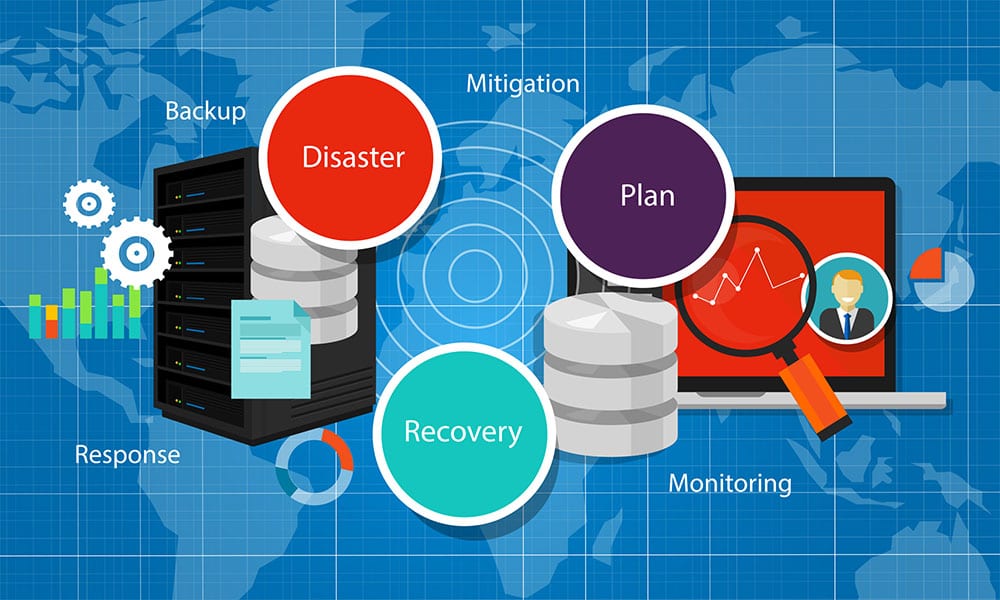In today’s world, it is vital businesses prepare for any disaster that may be on the horizon.
Whether it’s a cyber breach or a fire breaking out in the office, disasters can be unexpected and impossible to escape. But making a BCDR plan is a critical element in protecting your business for whatever the situation.
A BCDR solution is there to minimise any interruptions or outages to business operations. If something like this does occur, a good BCDR plan will ensure your organisation gets back on its feet in no time, reducing risk of any data loss, financial implications or reputational impact.
When it comes to preparing your BCDR plan, various processes and strategies need to be continually tested and evaluated to ensure success.
And we believe it should include the following key ingredients…
![AdobeStock_89803680 [Converted]](https://purecloudsolutions.co.uk/wp-content/uploads/2020/07/Disaster-recovery-business-continuity-small-businesses.jpg)
Uncover what disaster means to you
Firstly we suggest outlining every disaster that you should prepare for. Some may be impossible to imagine but preparing for the worst case scenario for your business and industry is a good place to start. Here are just a few key things to consider including in your BCDR plan …
Natural Disasters: This is determined on your geographical location. But in the UK it is always best to prepare for certain types of natural disasters including floods, storms or snow that may trigger electrical outages. Address what problems may occur from these disasters and how to deal with them.
Cyber Breaches: Hackers are constantly looking for new ways to hack your IT network or systems and to steal your organisation’s data. It’s important to be vigilant and put in place regulations as part of your BCDR plan that support you in the event of a cyber breach.
Equipment Failure: Most organisations today heavily rely on technology for everyday use, so if they were to fail your organisations workflow could be put on hold disrupting your business operations. Prepare by having a robust backup solution in place should devices in your organisations malfunction, fail or are damaged.
Employee Unavailability: Do you have a plan in place if employees are suddenly away from the office due to personal emergencies or accidents? Train staff to do other employees roles so you always have someone available and trained to take on others workflow if needed.

Identify your goals and objectives
It’s important to identify the goals and objectives you want your BCDR plan to achieve and that meet your business needs.
These goals will help to guide the business continuity planning process, risk assessment and other factors involved with your BCDR plan.
To do this, establish a planning committee by selecting key employees to take responsibility and make decisions where necessary.
COMMUNICATION
Communication is critical when it comes to a disaster. Employees should know exactly what role and actions they should take following a disaster. This involves assigning different tasks for those most suitable e.g. getting systems back up and running, setting up new workstations or redirecting phone calls from customers. These roles should be communicated prior to any disaster & ideally, staff should sign a document to ensure accountability.
As well as communication with employees being vital, so is communication with customers and vendors. Whether that’s through your website, by phone or by email, keep others around you informed of your current situation.
Outline any business procedures required to contact them and prepare backup plans in case phone lines, emails or website goes down.

Image Source: Vantage Circle

TESTING
Routine tests are key to evaluating how effective your BCDR plan is. The more tests you run, the better the outcome will be if a disaster strikes. This could be simulation exercises or regular training sessions and should always involve your staff.
Your BCDR plan is only as good as the outcome of your previous test, so take time to get them right and uncover what works well and what doesn’t.
Procedures should be constantly evaluated and documented to accommodate for any changing risks.
Data continuity
Data continuity can help to minimise the impact of disaster on your organisation by ensuring you can continue to operate and maintain business as usual. To do this, alternative processes should be put in place so key operations can still go ahead.
Invest in failover systems in multiple locations and build a resilient system that eliminates every single point of failure.
Finally, ensure to document exactly where all your data is stored so it can easily be located and restored to these same locations.

BCDR PLans PROTECT YOUR BUSINESS
When your business relies on technology to operate, developing a successful BCDR plan is key to delivering business results during critical moments. Register your interest today for FREE advice on building a tailored BCDR plan that works. Call us on 0333 150 6780, email us on or fill out the contact form below and a member of the team will be in touch.





Recent Comments